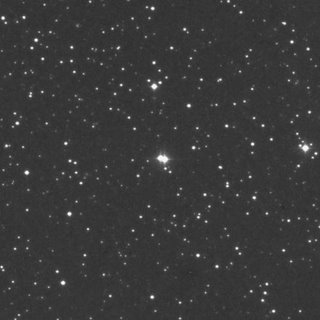A planet burnt beyond recognition
 The two bright stars right at the center of this image form the binary star system ADS 16402. Binary star systems are common, maybe even to the extent that the majority of stars are part of a binary.
The two bright stars right at the center of this image form the binary star system ADS 16402. Binary star systems are common, maybe even to the extent that the majority of stars are part of a binary.
What makes ADS 16402 particularly interesting is a discovery announced only a few days ago. ADS 16402 b (the star on the left of the two) has a planet. What is even more astounding is that it was discovered using a network of telescopes little bigger than a SLR camera: HATnet.
Extra-solar planets (planets outside of our own Solar system) are nothing new. Starting with the first robust discovery a decade ago there are now 206 extra-solar planets known to astronomy (as of today, visit the Exoplanets Encyclopedia to find the latest details). Most are Jupiter-like gas giants.
This planet, named HAT-P-1b, is nevertheless something special. It weighs in at about half of Jupiter's mass, but its radius is approximately 40% larger than Jupiter's. Put those two things together and you have a planet with a density of ~0.4 g/cc, i.e. its less dense than water.
So what you might say? Well, this is an unusually low density for a planet, in fact standard planetary structure theory would say you can't have a gas giant planet with such a low density.
The figure on the right comes from the discovery paper of HAT-P-1b (Bakos et al 2006, E-print: astro-ph/0609369). Its a plot of the mass vs radius for the known exo-planets, and its clear that HAT-P-1b and the similarly weird HD 209458b are well outside the norm.
Why is HAT-P-1b so weird? Well, it orbits very close to its parent star. Its average distance from its star is only 5% of the distance between the Earth and the Sun, and about 1% of the distance between Jupiter and the Sun. This itself is not that unusual: many giant exo-planets, in particular the first ones to be found, orbit close to their stars despite having almost certainly formed much further out (which is a fascinating topic in its own right).
One possibility to explain the bloated puffed up nature of HAT-P-1b is that its being cooked by its parent star. IF some fraction of the stellar energy falling on the planet gets transported deep down in the atmosphere then the atmosphere could be puffed up. Its not enough just to heat the very surface layers though. This is a cool-sounding idea, and I liked the idea enough to title this post along those lines (paraphrasing from a Mentallo & the Fixer album). However the problem is that other close-in exo-planets aren't puffed up.
What are the other options? Tidal heating, either from an eccentric orbit, or from a Cassini State (its rotation axis lying close to its orbital plane, unlike the Earth where they're about 90 degree apart), might heat the planets interior sufficiently to alter the atmosphere drastically enough. But these hypotheses, as Bakos et al write, are "ad hoc; they require unusual circumstances for which there is no independent evidence." Ad hoc solutions are bad form in science, as they so often turn out ot be wrong.
So the mystery of HAT-P-1b remains, for now.





No comments:
Post a Comment